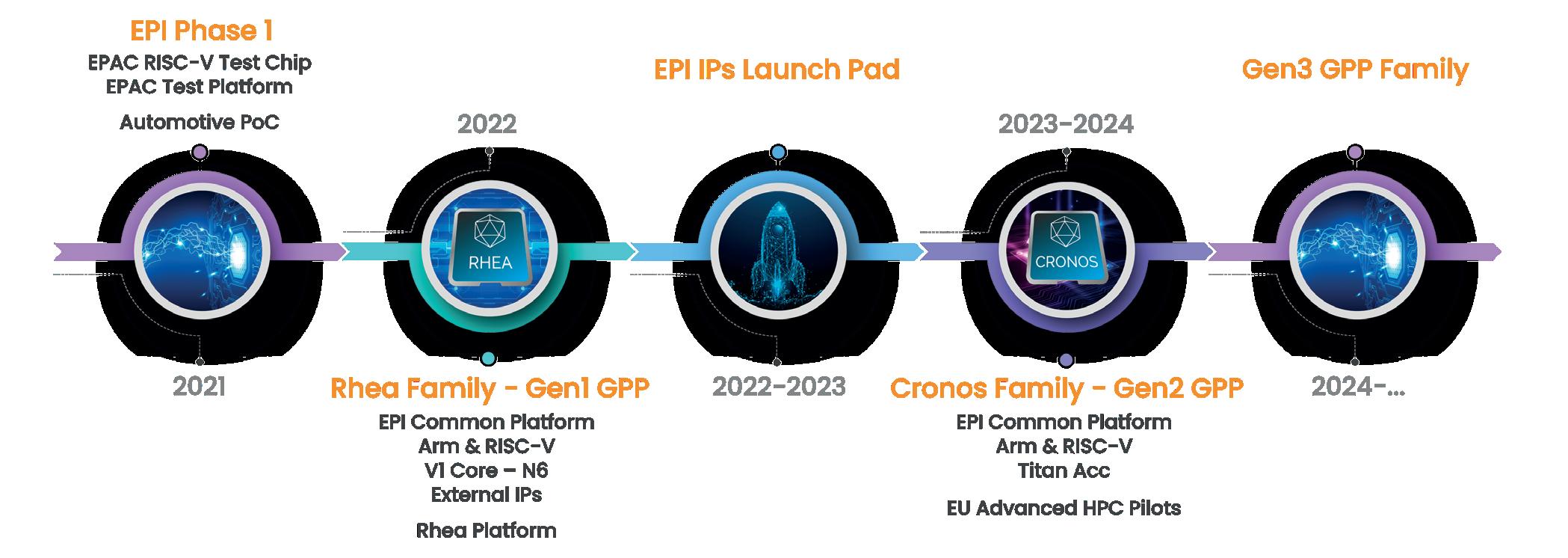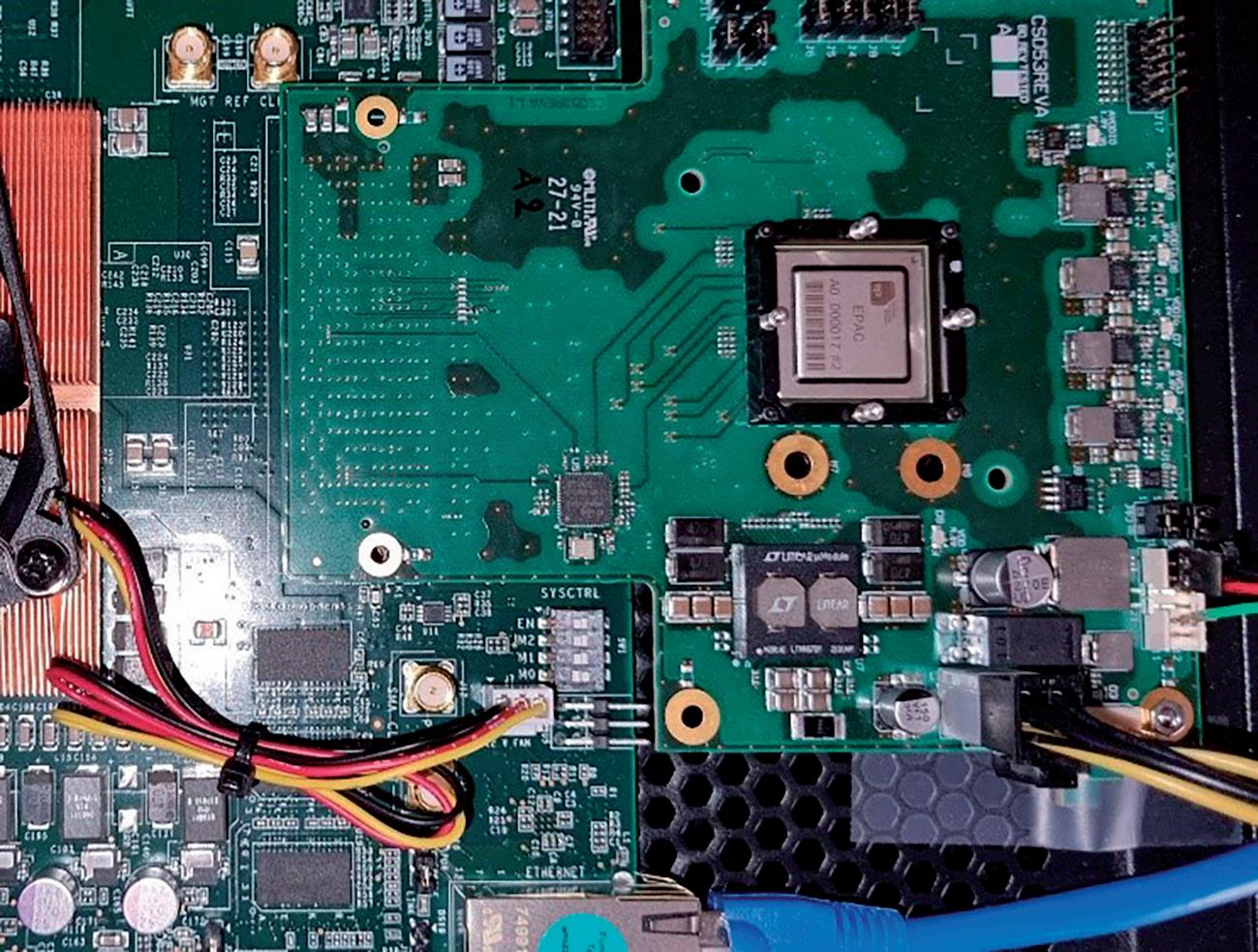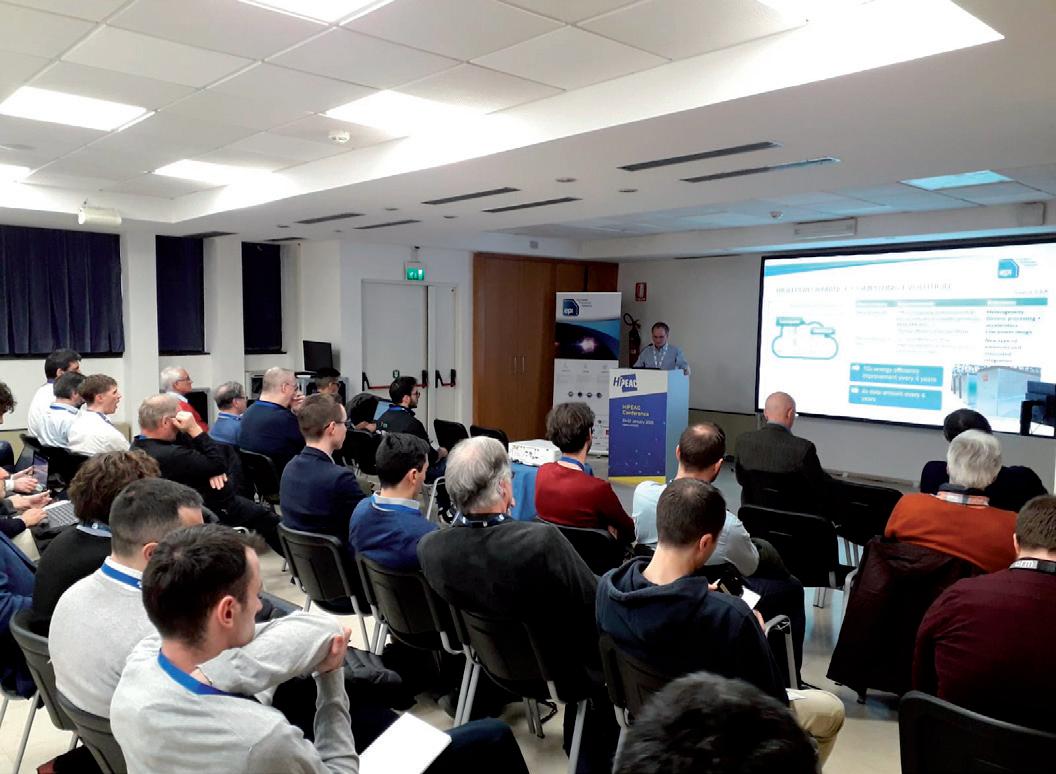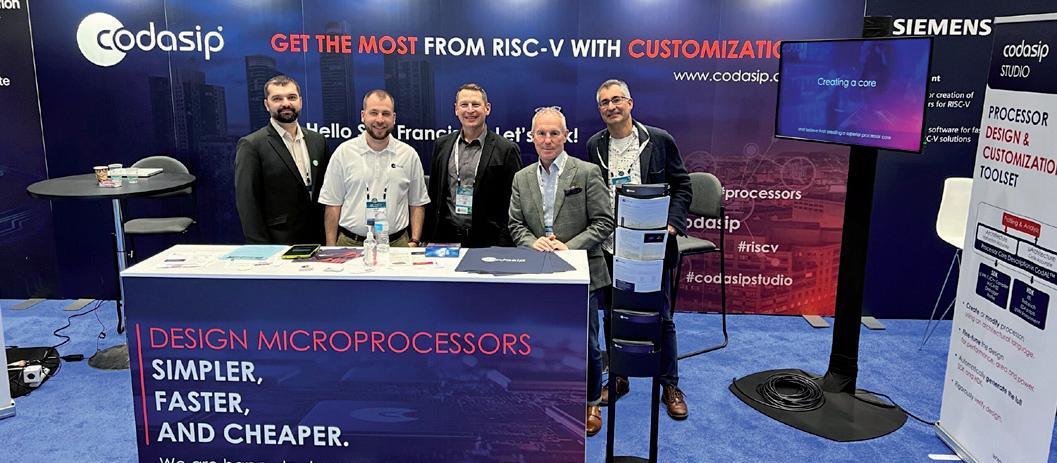10 minute read
Special feature: Reaching for the stars
from HiPEACinfo 65
by HiPEAC
Next Article
Shooting for the moon
Taking European technology to the next level
“Kennedy understood that many of the lasting benefits of innovation happen not just at the end of the process, but along the way, through dynamic spillovers. And in the case of America’s moonshot, he turned out to be right. Much of the technology in our smartphones today can be traced back to the Apollo program and related missions.” Maria Mazzucato, Professor in the Economics of Innovation and Public Value, University College London. ‘Mobilizing for a Climate Moonshot’, Project Syndicate, 8 October 2019 ‘The race for the most advanced chips is a race about technological and industrial leadership.’ Thierry Breton, European Commissioner for Internal Market, September 2021
Traditionally, Europe has lagged behind the United States and China in terms of transforming basic research into cutting-edge, market-ready technology. This means that Europe has found itself dependent on imports from other parts of the world, making the continent vulnerable to fluctuating geopolitics. In the case of technologies as fundamental and widespread as computer chips, this can have an impact on whole industries.
Little wonder, then, that figures such as HiPEAC co-founder Mateo Valero (Barcelona Supercomputing Center) began calling for an ‘Airbus of high-performance computing (HPC)’ to strengthen the European Union’s chip-making capabilities some years ago. In 2018, a major programme was launched to deliver designed-in-Europe, low-power microprocessors for domestic supercomputers: the European Processor Initiative (EPI).
From the outset, it was clear that EPI would be a colossal undertaking: led by the French information and communication technology (ICT) giant Atos, by 2021 the consortium comprised a total of 28 partners from 10 European countries, among them many HiPEAC members. The total budget for the first three-year phase was €80 million. To bring the high-performance, lowpower processor to market, a company was created, SiPearl, which has since opened subsidiaries in Germany and Spain in addition to its French headquarters. In a nod to the scale of the project’s ambitions, the processor generations have been named after Titans in Greek mythology.
Now that the first phase, SGA1, has come to an end, EPI is celebrating achievements resulting from collaborative working and intense research, which no single partner could have achieved by itself. Notably, these were delivered in an impressively short timeframe, with a relatively modest budget in chip-design terms, and during a global pandemic, with all the associated challenges for working in collaboration.
‘I’m proud of the outstanding results achieved by EPI teams after only three years of cooperation, paving the way towards Europe’s technological sovereignty,’ said Eric Monchalin, chairman of the EPI Board. ‘This has created favourable conditions for the launch of the next phase to successfully deliver the European processors and accelerators for the EUPEX (EUropean Pilot for Exascale) and TEP (The European Pilot) projects, the precursors to European exascale systems.’
The following are some of the highlights from the first three years.

General Purpose Processor (GPP)
Led by Atos, with the contribution of SiPearl and other EPI partners, this stream defined architectural specifications for Rhea, the first generation of the EPI GPP implementation, using a co-design methodology. With 29 RISC-V cores, Rhea’s Arm Neoverse V1 architecture will offer an effective, scalable and customizable solution for HPC applications.
The EPI GPP achieved register-transfer level (RTL) completion status, and the full Rhea design implementation is currently at the validation stage, using emulations. The Rhea processor will be instrumental in the launch of European exascale computers in 2023.
Rhea will integrate technologies by EPI partners and offers unique features in terms of memory architecture, memory bandwidth optimization, security, and power management.

Memory
To help evaluate architectural choices for the memory controller intellectual property (IP) – a critical factor in performance – CEA developed a complete simulation platform that allows efficient analysis of the memory device interface by decoding and tracking memory commands and data.
Security
Standalone intellectual property (IP) in the form of the Security Management System (SMS) developed by ProvenRun will provide advanced, sovereign security for HPC and edge processors. To further bolster security, the University of Pisa contributed a set of cryptography IPs named Crypto Tile, which were integrated into Rhea by SiPearl. This provides a hardware security module with full security services for high-end symmetric, asymmetric and hashing cryptography, all at substantially increased throughput and decreased energy use in comparison to a software solution.
Other Crypto Tile features include secure key storage, secure IP configuration, side-channel attack protection, on-chip true random number generation (TRNG), support of Linux kernel drivers, extreme key lengths for maximum security levels, and high speed en(de)cryption throughput, as well as the basis for post-quantum cryptographic support.
Power
An open-source, RISC-V based power controller designed by the University of Bologna and ETH Zurich was integrated into Rhea, harnessing advanced control and artificial intelligence (AI) algorithms for the power management of large-scale systems-on-chip (SoCs).
In addition, Atos and E4 designed and manufactured the Voltage Regulator reference platform, emulated on a field-programmable gate array (FPGA) board, based on STMicroelectronics technology.
European Processor Accelerator (EPAC)

The EPAC stream set out to deliver energy-efficient acceleration for HPC and AI workloads. With the EPAC test chip proof of concept, EPI has demonstrated that it is possible to create an exclusively European design based on open-source instruction set architectures (ISAs), ensuring freedom from proprietary licences and export restrictions.
This stream fully embraced the open-source philosophy of give and take, contributing to the expansion of the RISC-V ecosystem and adding to the LLVM compiler database. The EPAC systems and FPGA software development vehicles make full use of the Linux operating system and contribute to the community with patches, device drivers, and additional functionality to popular open-source HPC software packages such as OpenMP and MPI. Furthermore, parts of the hardware such as the STX (stencil/

tensor accelerator) were developed using a permissively licensed open-source approach around the PULP platform.
The following suite of technologies was developed as part of this stream: • The EPAC vector processing unit (VPU), designed by BSC and the University of Zagreb, shows the use of RISC-V longvector architectures for high-performance computing is a viable approach, delivering high performance on a low energy budget, and that it can be scaled up in future. • The vector unit is driven by Semidynamics’ vector-specialized
Avispado RISC-V core and Gazzillion Misses™ technology for energy-efficient processing. • The dedicated and flexible RISC-V based many-core stencil and tensor accelerator (STX), designed by ETH Zurich and Fraunhofer, leverages stencil processing units to offer exceptional energy efficiency and programmability for machine-learning and stencil workloads. • Meanwhile, the variable precision accelerator (VRP), designed by CEA, enhances efficiency and reliability for scientific highperformance computing applications such as multiphysics simulations. • The EPAC test chip also includes multiple distributed banks of shared L2 cache and coherence home nodes (L2HN) designed by FORTH and CHALMERS and optimized for the highbandwidth requirements of the vector processing units while offering a coherent view of the memory system that facilitates multicore programmability. • All the processing units and the shared L2HN banks are connected via a high-speed network-on-chip (NoC) in a modular manner that permits the system to scale up. The test chip also includes advanced SERDES technology for very highbandwidth off-chip and cross-chip communication. Both the
NoC and SERDES have been designed by Extoll. • The PCB (daughter board) to enable the testing of the EPAC test chip were designed and developed by E4.
Automotive
Coordinated by Infineon, the automotive stream paved the way for road-capable autonomous cars thanks to the delivery of an embedded high-performance computer (eHPC) platform and associated software development kit (SDK). This platform, in combination with a downsized, vehicle-tailored, general-purpose processor, meets future cars’ increasing demands for computing power in a cost-efficient, economically viable and functionally safe way.
A road-approved BMW X5 demonstrated the proof of concept for the pioneering eHPC microcontroller unit (MCU), integrated into a specially designed flexible modular computing platform, together with several EPI technology IPs. Numerous test drives were performed to collect data and evaluate test scenarios. Among other features, the platform includes AI-supported integrated cameras and Elektrobit radar imaging analysis software, with integrated preparation for the use of EPI accelerators in the system.
Infineon also expanded the architecture and performance ability of the automotive microcontroller in terms of architecture and performance so that it can act as a master, controlling and surveying a number of aspects. These include safety, security, fall back or redundancy for reduced application, with regard to the top Automotive Safety Integrity Level D (ASIL D) at system level, which is required for autonomous driving applications.
The platform created is scalable and open to further technologies: the modular computing platform has slots for other technologies developed as part of EPI, including: • future automotive versions of the GPP • the EPAC RISC-V based accelerator • the Kalray Massively Parallel Processor Array (MPPA®) accelerator tile, demonstrated for object detection using
Kalray’s MPPA®-based Coolidge™ processor • the Menta eFPGA
Tests now reveal that EPI has specific technologies suitable for autonomous driving up to at least level 4 – where the vehicle drives independently most of the time – thus paving the way for the future.
The automotive stream also included the development of a complete software ecosystem, to a large extent based on products



by automotive software specialist Elektrobit. This includes the automotive eHPC platform software stack, including the classic automotive open operating system architecture (AUTOSAR) development for auto eHPC MCUs, and the adaptive AUTOSAR development for HPC GPPs and the L4Re hypervisor (virtualization) that are crucial for automotive applications. With regard to safety, a specific concept was jointly created for a software lockstep.
Common activities
Acting as a provider for other technical streams, this stream delivered a number of results to support the work done elsewhere in the project. First, it established a co-design process to shape the design of European processors. Simulations and models were created to pin down the impact of design decisions on the performance of future applications. A benchmark suite of over 40 applications was used to support co-design and later evaluate the EPI processors. Applications were also prepared to run on future EPI systems, by adapting and testing them on comparable hardware platforms and emulators.
The specification of a ‘common platform’ architecture was also defined and used as a backbone for architecture exploration, as the starting point for the GPP implementation, and to define guidelines for security and heterogeneous integration.
Another important result was the integration of the power management design in the GPP specifications: power management firmware, off-chip integration consolidating power distribution board design, PLDA interface integration, and consolidation of the power management hardware integration.
Work was also done on multiple aspects of the support of system software development: general and hybrid programming environments, OpenMP and MPI runtimes, OpenMP extra threads support for dynamic load balancing and the introspection-based scheduling mechanism in the LLVM OpenMP runtime, offloading for both GCC and LLVM toolchains, testing of power and energy monitoring libraries on the available reference Arm Platform and the resource manager.
Another notable achievement was the development of three tools – gem5, MUSA and SESAM/VPSim – for a complete multi-level simulation environment that provides relevant virtual prototypes for a wide range of needs encountered in the EPI streams. These tools demonstrated broad capabilities, including detailed chiplet- and NoC-level simulation, system simulation for software design, and performance evaluation for design space exploration and hardware co-design activities. • A gem5 cycle-accurate, computer architecture simulation package of Rhea, developed by Jülich and FORTH, with models for central processing unit (CPU) cores, memory devices, coherent caches and on-chip networks. • MUSA, developed by BSC, which allows simulation of different communication neworks, numbers of cores per node, and relevant microarchitectural parameters. • SESAM/VPSim, developed by CEA, which includes fast on-chip network and cache performance models, as well as decoupling the simulation of functional and extra-functional behaviours.

Future work
The second phase of the European Processor Initiative, SGA2, was recently launched. Building on the successes of SGA1, this phase will seek to design the second generation of the general purpose processor, named Cronos. HiPEAC members continue to be integral to this research effort, and to furthering Europe’s ambitions for technological sovereignty.
The European Processor Initiative has received funding from the European Union’s Horizon 2020 research and innovation programme under grant agreement no. 826647.


